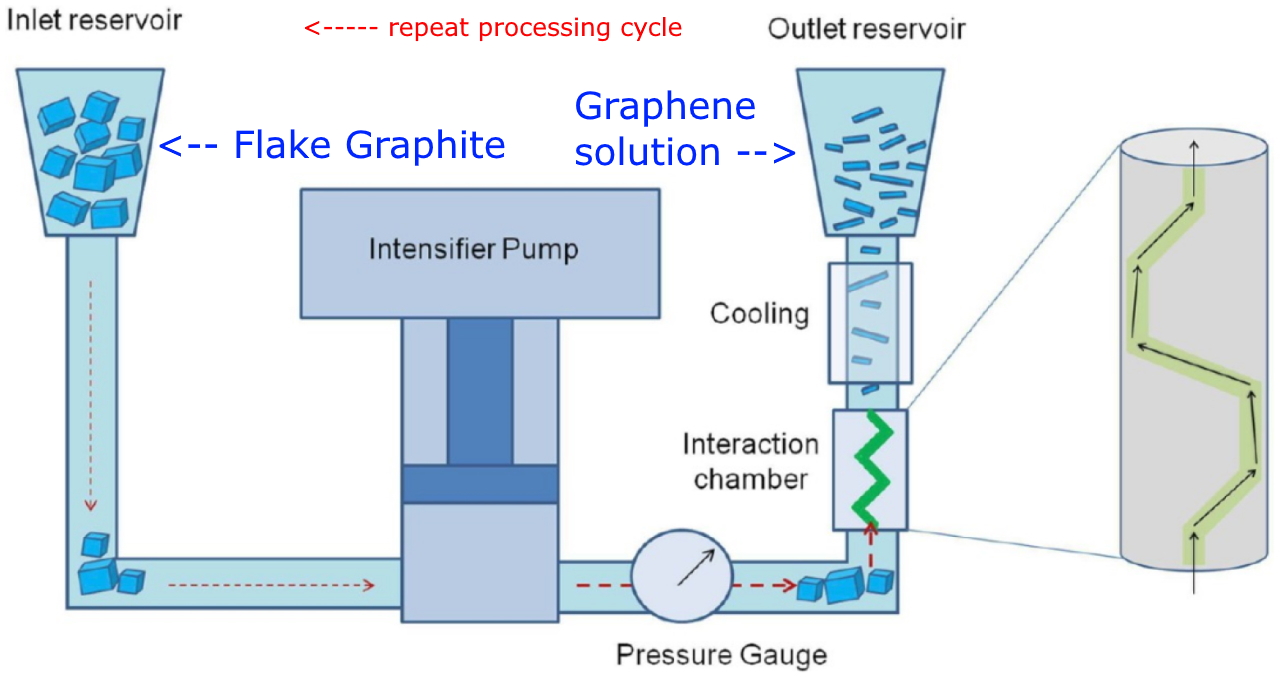Graphene exfoliation石墨烯剥离
Our High Pressure Homogenizers provide an alternative method to help meet the challenges of Graphene production with improvments in production scalability, increased Graphene yields and potentially lower production costs.
The exceptional properties of Graphene include its ultra high tensile strength (100 times stronger than steel), excellent electrical and thermal conductivity and the thinnest 2D material known.
Graphene is then suitable for a wide range of next-generation applications including when utilized in 'layers' with other 2D nanomaterials. It is also the fundamental structural element of Carbon Nanotubes.
High Pressure Homogenization (HPH) is gaining in popularity as an effective mechanical Graphene exfoliation method. Learn more below.
Graphene exfoliation methods
Generally, two different strategies can be applied:
1. Top Down: Graphene produced from graphite by exfoliation - using any of the following methods - mechanical (including our Homogenizers), chemcial and oxidative. Mechanical methods also include (ultra) sonication and high shear mixing.
2. Bottom Up: Graphene produced from gases by Chemical Vapour Deposition (CVD).
There is also the approach that involves the unzipping of carbon nanotubes (CNTs) to obtain graphene nanoribbons / nano-strips.
Graphene production - High Pressure Homogenizers - Liquid-phase exfoliation (LPE)
Our industry-leading high pressure technology provides one of the most promising methods to help meet challenges listed below for Graphene exfoliation.
我们的高压均质机提供了另一种方法,帮助解决石墨烯生产的挑战,提高了生产可扩展性,增加了石墨烯产量,并可能降低生产成本。
石墨烯的特殊特性包括超高的抗拉强度(比钢强100倍)、优异的电导率和热导率,以及已知最薄的二维材料。
石墨烯适用于广泛的下一代应用,包括与其他二维纳米材料“分层”使用。它也是碳纳米管的基本结构元素。
高压均质化(HPH)作为一种有效的机械石墨烯剥离方法越来越受欢迎。
石墨烯剥离方法
一般来说,可以采用两种不同的策略:
1. 自顶向下:从石墨中通过剥落产生石墨烯-使用以下任何一种方法-机械(包括我们的均质机),化学和氧化。机械方法还包括(超声波)和高剪切混合。
2. 由下而上:通过化学气相沉积(CVD)从气体中产生石墨烯。
还有一种方法是将碳纳米管(CNTs)解压缩以获得石墨烯纳米带/纳米带。
石墨烯生产-高压均质器-液相剥离(LPE)
我们的行业领先的高压技术提供了最有前途的方法之一,以帮助解决以下石墨烯剥离的挑战。

生产规模均质系统
Challenges of Graphene production
Scalability of production to high levels without negative impact on its properties.
Low graphene yields.
The quality of graphene produced and so its electrical conductivity and strength.
Some methods produce hazardous waste and poisonous gases.
Addressing Scalability
One of its most promising features of our high pressure Homogenizers is their ability to scale-up to higher production levels and to do so with repeatable results for improved product consistency.
One example would be the production of large volumes of conductive Graphene ink from a flake graphite solution which undergoes high energy / high-shear in our homogenizer processing chamber. The end result (after several processing cycles) is a highly concentrated graphene suspension.
Increasing Graphene yields.
For example, when processing Flake Graphite the yields of Graphene (when not using our technology) are typically small. Obviously this is inefficient and so increases production costs and time.
The high shear process of our Homogenizers can increase Graphene yields and this percentage can be increased, incrementally, in each additional cycle through the Homogenizer .
Improving Graphene quality.
The quality / purity of Graphene produced can be determined by multiple factors, not just the method of Graphite exfoliation used.
Pristine Graphene can be achieved when using a class-leading Homogenizer, like ours, when using high-quality Flake Graphite as the raw material. HPH can be used to ensure mild exfoliation conditions that can help to decrease the formation of defects.
Other factors that can have affect on Graphene purity include the introduction of various solvents or surfactant/water solutions.
Another benefits of using HPH is that by adjusting the pressure and processing time the thickness distribution and Graphene 'sheet' area distribution can be controlled.
Lowering Graphene Production costs.
HPH can utilize Flake Graphite - a cheap and abundant source - as the raw material for Graphene production.
HPH has the ability for scaleable, continuous processing to maximise Graphene production, yields and with repeatable results.
HPH does not (normally) require the use expensive substrates during processing.
As shown in the diagram below, the solution is recycled from the outlet reservoir back in to the inlet reservoir (for another cycle) and this can increases yield and lower production costs.
During each cycle the graphite flakes, which can move within the liquid, can be exfoliated repeatedly at different positions inside the homogenizer chamber whilst under very high pressure. Tests show that Graphene particles produced are about 1 to 2 micron in lateral size with a uniform end product.
So our High Pressure Homogenzers are proving to be a cost-effective, and efficient, Graphene exfoliation method.
石墨烯生产的挑战
产品的高可伸缩性,而不会对其属性产生负面影响。
石墨烯的产量较低。
石墨烯的质量决定了它的导电性和强度。
有些方法会产生有害废物和有毒气体。
解决可伸缩性
我们的高压均质机最有前途的功能之一是他们的能力扩大到更高的生产水平,并这样做的可重复的结果,以提高产品的一致性。
一个例子是,在我们的高压均质机加工室中,从片状石墨溶液中经过高能量/高剪切生产出大量导电石墨烯墨水。最终的结果(经过几个加工循环)是一个高度浓缩的石墨烯悬浮液。
增加石墨烯产量。
例如,在加工片状石墨时,石墨烯的产量(不使用我们的技术时)通常很小。显然,这是低效的,因此增加了生产成本和时间。
我们的高压均质机的高剪切过程可以增加石墨烯的产量,并且在每一个额外的高压均质机循环中,该百分比可以逐步增加。
提高石墨烯的质量。
石墨烯的质量/纯度可以由多种因素决定,而不仅仅是使用的石墨剥离方法。
当使用一流的均质机,如我们的,当使用高质量的片状石墨作为原料时,可以获得纯净的石墨烯。HPH可用于确保温和的剥离条件,有助于减少缺陷的形成。
影响石墨烯纯度的其他因素包括各种溶剂或表面活性剂/水溶液的引入。
使用HPH的另一个好处是,通过调整压力和加工时间,可以控制厚度分布和石墨烯“薄片”的面积分布。
降低石墨烯生产成本。
HPH可以利用片状石墨——一种廉价而丰富的资源——作为石墨烯生产的原料。
HPH具有可扩展的连续加工能力,以最大化石墨烯的生产、产量和可重复的结果。
HPH(通常)不需要在加工过程中使用昂贵的基材。
如下图所示,溶液从出口储层循环回到进口储层(进行另一个循环),这可以提高产量,降低生产成本。
在每个循环过程中,可以在液体中移动的石墨片可以在均质器腔内的不同位置重复脱落,同时处于非常高的压力下。测试表明,生产的石墨烯颗粒横向尺寸约为1至2微米,最终产品均匀。
因此,我们的高压均质机被证明是一种成本效益高、效率高的石墨烯剥离方法。







